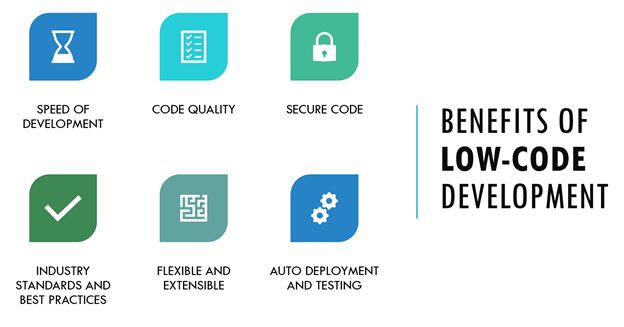Low-code development of applications significantly increases accessibility for non-developers. They are often referred to as "citizen developers," because of a variety of key aspects: Intuitive visual interfaces:
Drag-and-Drop Builders: Low-code platforms come with drag-and-drop interfaces that let non-developers create apps without having to write code. Development is now easier for those who have no technical background.
WYSIWYG: WYSIWYG editors are "What you see is what you Get" editors that allow users to create workflows and interfaces in a similar manner to the finished product. This makes it easier to comprehend and use.
Simple logic and Workflow Design
Visual Workflow Modeling: Users may develop business processes and apply logic through visual flowcharts and models, which are more intuitive than traditional coding methods.
Low-code platforms usually come with pre-built logic components (e.g. condition statements, loops) that eliminate the requirement for complex coding.
Reusable Templates and Components
Template libraries that are pre-built: Many low code platforms provide an application library that can be used for the most common types of applications, providing non-developers to have a foundation to build on and later alter.
Reusable Widgets and Modules: Users are able to use reusable widgets. This allows for a simpler creation and eliminates the requirement for in-depth knowledge.
Guided Development and Tutorials
Step-by-Step Guides: Platforms often offer a set of development guides along with tutorials and guidelines to assist novice developers in developing applications.
Interactive Tutorials: Interactive and hands-on tutorials enable users to learn by doing. They can build confidence making use of the platform.
Integration with Existing Tools:
Seamless Integration: Low-code platforms are built to integrate seamlessly with the tools and systems within business (e.g. the CRM or ERP) This permits non-developers to build applications that can work within existing workflows.
APIs connectors and APIs: These devices make integration easier by allowing non-developers (or even users) to link their applications to external services.
Collaboration Features:
Team Collaboration: Features like real-time collaboration, as well as shared workspaces enable non-developers to work with professionals, business analysts, and other stakeholders effectively.
Access control based on role: Role levels are able to be set for non-developers to ensure they can still contribute to the development process, but without jeopardizing security.
Automated Debugging, Testing and Debugging
Low-code platforms usually come with testing and debugging software that automates these processes. This makes it simpler for non-developers to ensure that the functionality of their apps.
Platform detects problems when they happen and suggests solutions. This helps non-developers with troubleshooting.
Development using low-code is more accessible to non-developers because it makes development more accessible to everyone. Low-code platforms offer intuitive, visual tools, guided experiences and enable business users actively participate in developing updates, maintaining and enhancing applications. Read the best Low-code Platform for application development for site advice including stored sql procedures, stored sql procedures, cross platform app dev, no code platforms, azure sql databases, rapid action development, app development platform, lowcode no code, cross platform app development, rapid applications and more.

Advantages Of Low-Code Application Development In Terms Of Governance And Security
Low-code development can bring many advantages in terms of security and governance. These are crucial to ensure that applications are safe, secure and well-managed through their entire lifecycle. Here are a few of the main advantages.
Unified Management Console - Low-code platforms have a central administration console for administrators to manage and oversee every application. This allows for consistent governance across the entire organization.
Role-Based Access Control (RBAC) The majority of these platforms offer strong access control based on role that allows administrators to establish and enforce access policy. This ensures that only those who have authorization are able to modify or access certain parts of the application.
Conformity and Regulatory Conformity:
A lot of low-code platforms have built-in compliance functions. For example, they are designed in accordance with the standards of the industry regulations, laws and standards (e.g. HIPAA, GDPR). They offer frameworks and instruments to ensure that applications comply with standards.
Audit Trails and Logging Audit trails and logs that are comprehensive can be integrated to enable companies to monitor changes, monitor access and ensure compliance.
Additional Security Measures
Data Encryption. Low-code platforms usually offer built-in encrypted data, both in transit and when in rest. This protects sensitive information.
Security Certifications: A lot of providers of low-code software have security certifications such as ISO 27001 or SOC 2 to prove that they adhere to high standards. These certificates provide further assurance to users.
Automated updates for security:
Regular Updates and Patches Low-code platforms typically are equipped to handle security patches and updates regularly. This means that apps are protected against the most recent threats without the need for developers to manually alter their settings.
Security Monitoring - Continuous security monitoring is often comprised. It provides real-time insight and alerts about possible security threats.
Data Governance
Data Access Policies These systems allow organisations to create data access policies and then enforce these policies to ensure that data is only available to authorized users. They also ensure the data is utilized in a proper manner.
Data Masking Anonymization: Built-in data masking tools and features for anonymization help safeguard sensitive data, particularly during development and testing environments.
Consistent Management of the lifecycle of an application
Development and deployment pipelines: Low-code platforms provide integrated development and deployment, which includes security tests. This guarantees security throughout the lifecycle of an application.
Version Control. Integrated version management can help to track and reverse any changes that are made to the program, while ensuring that the integrity of it is protected.
Authorization and User Authentication:
Single Sign-On (SSO) Support for single sign-on as well as other advanced authentication techniques simplifies user management and enhances security.
Multi-Factor Authentication A number of platforms have integrated functionality to verify multi-factor identities and provide an additional layer of security.
Policy Enforcement and Compliance Monitoring:
Low-code platforms include templates for policies predefined and can assist organizations in the implementation of governance policies and security policies.
Compliance Monitoring Tools: These provide continuous monitoring and report on compliance status. This allows you to spot potential problems and address them proactively.
Integration with Existing Security Infrastructure:
Seamless Integration: Low-code platforms are designed to work seamlessly with existing security infrastructure and tools, such as identity management solutions SIEMs (Security Information and Event Management Solutions), and firewalls.
API Security: Built-in API security features help protect the data of API users, ensure integrity of applications and provide secure integrations.
Training and the best practices
Good practices: Several platforms provide guidelines for the development of secure applications, and offer best practices. This helps non-developers to follow security standards.
Security Training: A few low-code providers offer security training as well as resources to educate users on how to create and maintain secure applications.
All in all, low-code app developers offer security and governance benefit that enables them to develop and manage applications in a safe, secure and secure manner. These platforms comprise the frameworks and tools needed to manage and oversee the development of applications, as well as safeguarding sensitive information while ensuring the compliance of regulations and enforcing rules. Take a look at the most popular here for Legacy application modernization with Low-code for blog examples including push notifications android, cross platform mobile development, rad development, application modernisation, database in azure, push alerts, app dev platform, push notifications, stored sql procedures, develop web app and more.

Low-Code Applications Offer Benefits In The Area Of Collaboration And Workflow
It is a good choice for companies that wish to improve team efficiency as well as streamline processes and enhance collaboration. Here are the key benefits: Improved Cross-Functional Collaboration:
Unified Development Environment Low-code platform provides one unified environment in which all members of the team including analysts, developers design, stakeholders, and more, can efficiently collaborate. This eliminates barriers.
Visual Development Tool: The drag and drop nature of platforms using low-code allows team members who are not technologically inclined to participate in the development process. They are able to make sure that the business's requirements are accurately analyzed and implemented.
Improved Communication
Real-Time Collaboration Features: Many platforms using low-code have real-time collaboration features, such as simultaneous editing, comments, and instant feedback. These features help in collaboration and cut down discussing back and forth.
Shared Workspaces Teams can collaborate using shared workspaces. These workspaces allow them to view, edit and discuss project components.
Streamlined Workflow
Built-in project management Tools Lowcode platforms usually come equipped with integrated tools that assist teams in planning, tracking, and directing their growth. This includes assigning tasks, tracking progress as well as deadline management.
Workflow Automation - Automating repetitive tasks or workflows allows teams to focus their efforts on more strategic projects and activities and improves the efficiency overall of the company.
Faster iteration cycles:
Rapid Prototyping Low-code platforms are perfect for rapid prototyping. Iterative development is also feasible, allowing the team to develop, test and refine their applications within shorter time. This allows for feedback to be quickly incorporated into the application and rapid improvement.
Agile Development Support Supporting agile methodology allows individuals and teams to work in small steps. This also makes it possible to swiftly adapt to changes.
Accessibility of Non-Developers
Citizen Development: Low-code platforms enable users in the business (citizens developers) to build and modify applications, with no having a deep understanding of programming. This relieves IT and development teams of the burden and allows faster responses to business needs.
Training and onboarding: Intuitive user interfaces and comprehensive resources for training help bring new team members up to level. This helps improve overall collaboration in the team.
Centralized Documentation, Knowledge Sharing, and Information Sharing
Documentation is integrated into low code platforms are often equipped with tools to build and manage documentation within the platform, making it easy for all project information to be centralized.
Knowledge Repositories : Teams can create knowledge repositories, which include templates, best practices and reused components. This facilitates knowledge sharing and minimizes the need for duplicate efforts.
Consistency and uniformity:
Standardized Components. The use of pre-built standard components provides the sameness throughout all software. This makes it easier for team members to understand and work with different aspects of their projects.
Governance and Compliance: Integrated in governance frameworks ensure all development follows organization standards and requirements of the regulatory environment, reducing risk of non-compliance and ensuring that the applications are of high-quality standards.
Feedback and Improvement Loops
Integrated Feedback Systems: Low-code platforms have integrated feedback systems that enable users to offer feedback about the application. The feedback can then be utilized in the creation of these applications.
Continuous Improvement: The capability for applications to quickly iterate and implement changes based off of feedback, ensuring that they are closely aligned with the requirements of the user as well as business objectives.
Visualization of Reporting
Real-Time Analysis Tools for Analytics and Reporting built into the software provide real-time insights on project progress, user interaction and overall performance. This enables the use of data to make decisions.
Visual Workflow Maps: Tools to map workflows or processes can be useful to teams in understanding their workflows. They also help to identify the bottlenecks that are present, as well as areas that require improvement.
Low-code development can offer many benefits in terms of workflow and collaboration. It can bring diverse teams together, improve processes, streamline communication, and boost teamwork. This creates an efficient and flexible developing environment that is collaboration-oriented.
